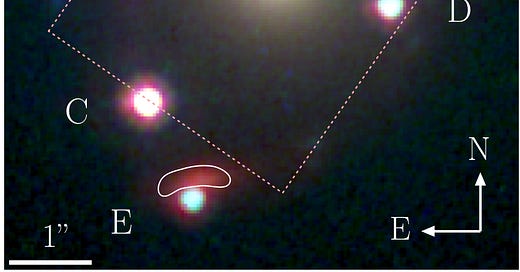I am Alessandro. I have been in astronomy since 2002.
If you are eager to have a playful attitude towards astronomy; you want to grow your interest in this science and you want to know how astronomy works “behind the scenes”, this is the place for you.
I am planning on sending this Newsletter every Sunday.
Mistakes will be made; I count on your feedback to make this newsletter a better place and provide you with increasingly better content.
You can follow my vlog on TikTok or my YouTube Channel .
📰 This week in Astronomy
The election of the 47th President of the United States was a big deal, not only for the citizens of that country but also for the repercussions that it has on the rest of the world. The election of a person who does not have at heart research and science is worrying. The big projects based in the United States are now at risk and there is reason to be concerned for the future of the US as a research partner. One thing that few people remember is that the main producers of detectors for astronomy are based or owned by companies based in the US.
On the bright side, this week there were a few interesting news and the choice of the astronomy paper of the week was particularly challenging.
European Research Council Synergy Grants
The Synergy Grants are a special kind of funding from the European Union which allows researchers to team up to study challenging scientific topics.
The result of this year's Synergy Grants is out. It is quite interesting to see which topics are tackled and where the people are based.
Congratulations to the awardees.
Memories from the 1990s
One of my first professional experiences with a telescope was with the New Technology Telescope (NTT) . In this interview, Dietrich Baade, a retired astronomer from the European Southern Observatory, shares memories from the golden days of this ground-breaking telescope.
📚😃Astronomical paper of the Week
Everyday, I check the papers which are published on astro-ph.
This is a good way to keep in touch with the latest news.
A word of caution: many of the papers published there have not passed the refereeing process.
In this section, I pick a paper for you.
If you want me to comment on a paper, just send it to me by the Friday prior to the publication of the newsletter.
This week’s paper is "J1721+8842: The first Einstein zig-zag lens (Dux et al.)"
🤩Why is it interesting?
Strong lensing is one of the most spectacular consequences of Einstein's Theory of General Relativity.
In short, if a large mass distorts the space-time, the path of a photon passing close to this mass will be modified. This is an effect which looks like a lens and therefore is called "lensing". The massive object which modifies the space-time is called "lens".
🤨 What is the paper about?
There are some very famous lenses like the Einstein Cross, where a quasar is behind a massive galaxy and the gravitational lensing effect produces four images of the quasar.
In the case investigated by this work, there are six images.
The "blob" at the centre of the image is the lens. It is a galaxy at redshift 0.184.
The arc close to the F was thought to be related with the lens but the authors report observations carried out with the JWST and show that it must belong to a galaxy at redshift 1.885.
The model that the authors propose for this system is that the point sources belong to a quasar at redshift 2.382 which are lensed by two galaxies, one at redshift 1.885 and one at redshift 0.184.
This article is particularly ingenious. It builds on a variety of very good observations and derives a very good model. This is a great piece of research.
📈📊Astronomy tip of the Week
I always felt unsettled when I read that "for small angles," the sine of the angle can be replaced by the value of the angle itself.
From a mathematical point of view, this is trivial. If you have some moderately advanced mathematical knowledge, you will see that this is the first order of a Taylor expansion.
What does "small angle" mean in the real world?
Is an arcsecond a small angle? In most programming languages (and most calculators), one must transform an angle from degree to radian before doing any trigonometrical function.
We have already seen that in one radian there are 206264 arcseconds. This means that 1 arcsecond is 4.8x10-6 randians. If I take the sin of 4.8x10-6, the result is... 4.8x10-6!
One arcmin is 60 arcseconds, right? This means that 1 arcmin is 2.9x10-4radians. If I take the sin of this number, guess how much I get? Well, 2.9x10-4.
Turns out that you can play this game all the way up to 5 degrees and you will still make an error which is less than 10%.
If you like to exercise your brain, you can just approximate 1 radians to be 2x105arcsec and you can start doing these numbers directly in your head!
How much is the sine of one degree?
One degree is 3600 arcsec and 1 arcsec is 1/2x105, this means:
3600 / 2 x 105 = 3.6 x 103 / 2 x 105 = 1.8 / 102 = 0.018
The real number is 0.017 but the difference is that the 0.018 was done completely in our heads!
Skill unlocked: trigonometry on top of your head.
🫣❓What is on the horizon?
Big conferences, big news or big events.
XIX Meeting of the Sociedad Chilena de Astronomía (Universidad de Tarapacá, Arica, Chile, 11-15 November)
Astroinformatics 2024 (Llanuras de Diana, Puerto Natales, Patagonia, Chile, 9-13 December 2024)
IAU Symposium 397 "UniversAI: Exploring the Universe with Artificial Intelligence" (Athens, Greece, 2-6 June 2025)





